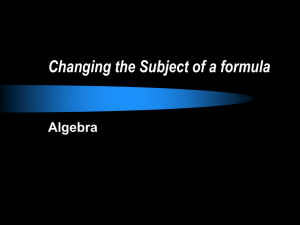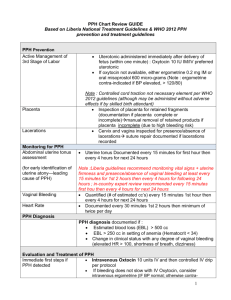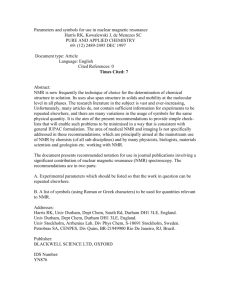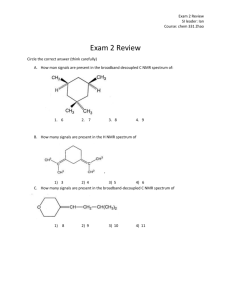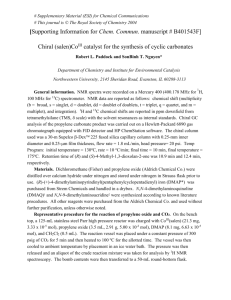FinalfullMS2N2_paper - University of St Andrews
advertisement
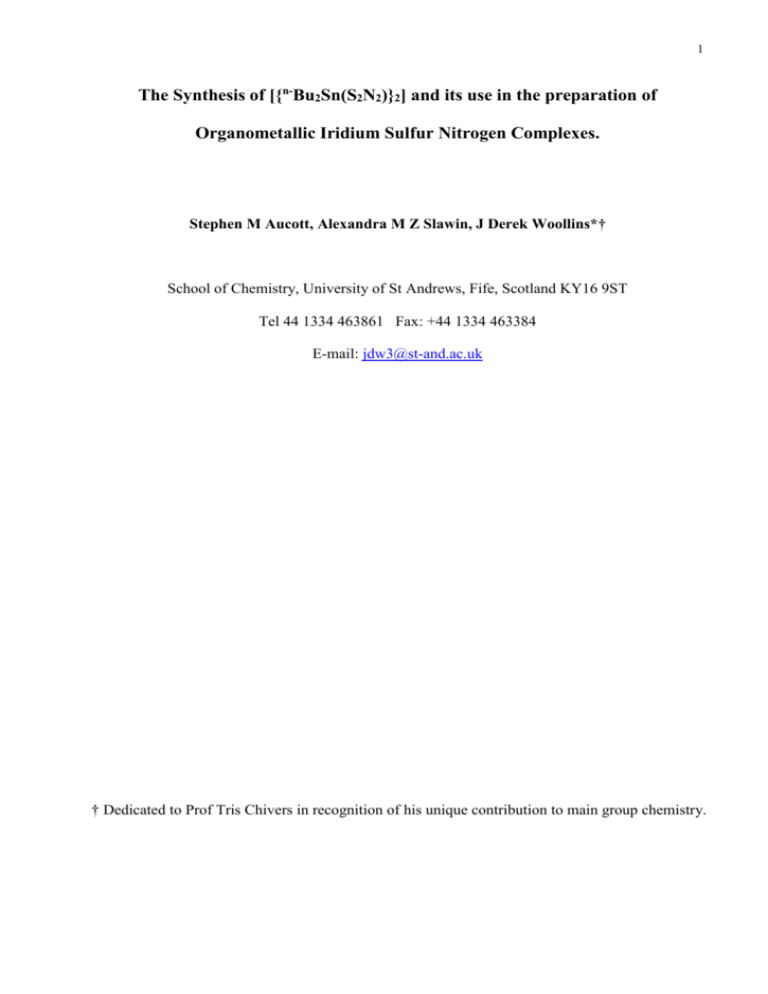
1
The Synthesis of [{n-Bu2Sn(S2N2)}2] and its use in the preparation of
Organometallic Iridium Sulfur Nitrogen Complexes.
Stephen M Aucott, Alexandra M Z Slawin, J Derek Woollins*†
School of Chemistry, University of St Andrews, Fife, Scotland KY16 9ST
Tel 44 1334 463861 Fax: +44 1334 463384
E-mail: jdw3@st-and.ac.uk
† Dedicated to Prof Tris Chivers in recognition of his unique contribution to main group chemistry.
2
The Synthesis of [{n-Bu2Sn(S2N2)}2] and its use in the preparation of Organometallic Iridium Sulfur
Nitrogen Complexes.Stephen M Aucott, Alexandra M Z Slawin, J Derek Woollins
Abstract- The addition of [n-Bu2SnCl2] to a solution of [S4N3][Cl] in liquid ammonia gave after
extraction of the dry reaction mixture the new tin disulfur dinitrido compound [{n-Bu2Sn(S2N2)}2] 1.
Reaction of [{n-Bu2Sn(S2N2)}2] 1 with the pentamethylcyclopentadienyl (Cp*) iridium derivatives
[{IrCl(-Cl)(5-C5Me5)}2] or [(5-C5Me5)IrCl2(PPh3)] gave different product which were dependent
on the reactant ratios. A 1:1 reaction between 1 and [{IrCl(-Cl)(5-C5Me5)}2] gave only [(5C5Me5)Ir(S2N2)] 2 in moderate yield, the same product in higher yield was obtained from a 2:1
reaction between 1 and [(5-C5Me5)IrCl2(PPh3)] . Reaction of 1 and [{IrCl(-Cl)(5-C5Me5)}2] [1:1
molar ratio] in the presence of NH4[PF6] gave the unusual bimetallic species [(5C5Me5)IrCl(PPh3)(S2N2)Ir(5-C5Me5)][PF6] 3. The X-ray crystal structures of 1, 2 and 3 are reported.
Keywords: Liquid Ammonia / tin sulfur-nitrogen reagent / Metathesis / Sulfur-Nitrogen
Metallacycle / Iridium Complexes
3
Introduction
Silyl and tin reagents have proven useful sources of sulfur-nitrogen fragments in the synthesis of
heterocycles (1,2). In many examples the driving force of these reactions is the formation of M-X (M
= Si or Sn; X = Br, Cl or F) bonds. Thus, for example bis(trimethylsilyl)sulfur diimide (Me 3Si)2N2S
reacts with S4N4Cl2 and o-C6H4(SCl)2, providing an [N2S]2- fragment, to give S5N6 (3) and oC6H4(SN)2S (4) respectively. Similarly [{Me2Sn(S2N2)}2] (5) supplies a [S2N2]2- fragment giving the
five-membered ring compounds C(O)S2N2 (6) and S(O)S2N2 (7) with carbonyl fluoride (COF2) and
thionyl fluoride (SOF2) respectively. Metal sulfur nitrides (see ref (8,9) for reviews) have been
prepared analogously from Group 14 sulfur-nitrogen reagents and metal halides. Examples include
formation of the eight-membered ring compound (MeAsNSN)2 (10) by reaction of (Me3Si)2N2S with
MeAsCl2 and complexes of the type [M(S2N2H)(PR3)2][X] (X = Me2SnCl3, PF6 or BF4) (11) by
treating cis-[MCl2(PR3)2] (M = Pt or Pd) with [{Me2Sn(S2N2)}2] via the elimination of Me3SiCl and
Me2SnCl2 respectively. Group 9 metal complexes containing the [S2N2]2- ligand are uncommon
(especially when compared to those of Group 10 and in particular those of platinum) examples being
[(5-C5H5)Co(S2N2)] (12-14) [(5-C5Me5)Co(S2N2)] (13-14) and [Ir(dppe)2(S2N2)][BPh4] (15) (dppe
= cis-1,2-bis(diphenylphosphino)ethane) prepared by the action of S4N4 on [(5-C5H5)Co(CO)2] or
[(5-C5H5)Co(cod)], [(5-C5Me5)Co(CO)2] and [Ir(dppe)2(CO)][BPh4] respectively. We report here
the synthesis of two new organometallic thiazene complexes of iridium [(5-C5Me5)Ir(S2N2)] 2 and
[(5-C5Me5)IrCl(PPh3)(S2N2)Ir(5-C5Me5)][PF6] 3 prepared by metathesis using [{n-Bu2Sn(S2N2)}2]
1 a new example of a dialkyl-SnS2N2 dimer of which only two other examples are known, the
aforementioned methyl derivative [{Me2Sn(S2N2)}2] (5) and the tert-butyl analogue [{tBu2Sn(S2N2)}2] (16,17).
Experimental
General
4
Unless otherwise stated, manipulations were performed under an oxygen-free nitrogen or argon
atmosphere using predried solvents and standard Schlenk techniques. The ammonia used was
obtained from BOC Ltd and dried by passage through a column of sodium hydroxide. The reagents
[S4N3][Cl] (18) and [{IrCl(-Cl)(5-C5Me5)}2] (19) were both prepared according to literature
procedures the latter from IrCl3·3H2O and pentamethylcyclopentadiene (both Strem). [(5C5Me5)IrCl2(PPh3)] was prepared by treating a CH2Cl2 solution of [{IrCl(-Cl)(5-C5Me5)}2] with 2
equivalents of PPh3 (Aldrich) followed by precipitation of the product by the addition of diethyl
ether. [n-Bu2SnCl2], NH4[PF6] and Ag[PF6] were purchased from Aldrich and used as received.
Infrared spectra were recorded as KBr pellets in the range 4000 -220 cm -1 on a Perkin-Elmer
system 2000 Fourier transform spectrometer. 1 H NMR spectra (250 MHz) were obtained
using a Bruker AC250 FT spectrometer with referenced to external SiMe 4 ,
31
P-{ 1 H} NMR
spectra (109.4 MHz or 101.3 MHz) either on a JEOL GSX270 or a Bruker AC250 FT
spectrometer with referenced to external H 3 PO 4 and
119
Sn-{ 1 H} NMR spectra (100.7
MHz) on a JEOL GSX270 spectrometer with referenced to external SnMe 4 . Microanalyses
were performed by the University of St Andrews Chemistry Department Service.
Preparations
[{ n- Bu 2 Sn(S 2 N 2 )} 2 ] 1. Ammonia (~200 cm 3 ) was condensed into a pre-cooled (–78°C,
cardice/acetone) Schlenk flask. [S 4 N 3 ][Cl] (9.22 g, 44.82 mmol) was added to the ammonia
in small portions over a 5 minute period. The resulting dark red reaction mixture was stirred
at –78°C for an additional 30 mins. [ n- Bu 2 SnCl 2 ] (27.24g, 89.64 mmol) was then added to
this mixture in small portions again over 5 minutes. Once the addition was complete the
reaction vessel was topped with a bubbler and stirred at –78°C for 2.5 hours then the
cooling bath was removed and the reaction gradually warmed to room temperature. Once
the ammonia had evaporated the reaction residue was dried in vacuo for about an hour
5
before being placed in a Sohxlet thimble. The residue was extracted with (40 -60°C)
petroleum ether (250 cm 3 ) until the extracts were nearly colourless (approx 4-5 hours). The
resulting deep orange/red solution was placed in a freezer (-20°C) overnight and the
deposited bright yellow crystals were collected by filtration under an atmosphere of
nitrogen or argon and washed with cold (< 0°C) hexanes (2 x 100 cm 3 ) and dried in vacuo.
Yield: 20.98 g, 72%. Microanalysis(%): Found (Calc. for C 16 H 36 N 4 S 4 Sn 2 ). C, 29.21 (29.45);
H, 5.29 (5.56); N, 8.50 (8.59); S 19.73 (19.62). 1 H NMR (C 6 D 6 ): 1.55-0.78 (m, 36 H,
Bu).
119
Sn-{ 1 H} (C 6 D 6 ) 37.8, (br s). EI/CI MS: m/z 267
210 SnS 2 N 2 (13%), 177
n-
n-
n-
BuSnS 2 N 2 (rel. intensity 20%),
BuSn (17%), 166 SnSN (11), 120 Sn (9), 64 S2 (100%) 60 NSN
(70) and 46 SN (35). IR (KBr disc): 2956m, 2918m, 2871m, 28 53m, 1063s, 1033vs, 899vs,
769m, 697s, 668w, 622s, 443m, 385m cm -1 .
[( 5 -C 5 Me 5 )Ir(S 2 N 2 )] 2. Method A. To an orange solution of [{IrCl( -Cl)( 5 -C 5 Me 5 )} 2 ]
(197 mg, 0.247 mmol) in dichloromethane (20 cm 3 ) was added [{ n- Bu 2 Sn(S 2 N 2 )} 2 ] 1 (161
mg, 0.248 mmol) in one portion. Over the course of 25 minutes the reaction mixture
darkened to a deep red colour and stirring was continued for a total of 8 hours. The reaction
mixture was evaporated to dryness under reduced pressure and then taken up in toluene (25
cm 3 ). The slightly cloudy dark orange solution was then added to a column of silica (20 x 2
cm) and first eluted with toluene (200 cm 3 ) which was discarded and then with acetone, the
orange band that moved with the solvent front was collected and taken to dryne ss. The
residue was dissolved in the minimum amount of warm (60 -70°C) toluene and stored at 4°C
overnight. The resulting well formed dark orange/red crystals were collected by suction
filtration and dried in vacuo. Yield: 107 mg, 53%
Method B. [( 5 -C 5 Me 5 )IrCl 2 (PPh 3 )] (245 mg, 0.371 mmol) and [{ n- Bu 2 Sn(S 2 N 2 )} 2 ] 1 (242
mg, 0.372 mmol) were stirred together in dichloromethane (20 cm 3 ) for 8 hours. The
6
product isolation procedure is exactly as described above in Method A. Yield: 131 mg,
84%. Microanalysis(%): Found (Calc. for C 10 H 15 IrN 2 S 2 ). C, 28.58 (28.57); H, 3.35 (3.60);
N, 6.31 (6.67); S 15.17 (15.22). 1 H NMR (C 6 D 6 ): 1.65 (s, 15 H, C 5 Me 5 ). FAB + MS: m/z
420 [M] + . IR (KBr disc): 2984w, 2962w, 2921w, 2854w, 1490w, 1458s, 1427w, 1376s,
1158w, 1079w, 1027vs, 957s, 701vs, 697w, 636s, 612w, 590w, 502s, 453m, 397s, 383w cm 1
.
[( 5 -C 5 Me 5 )IrCl(PPh 3 )(S 2 N 2 )Ir( 5 -C 5 Me 5 )][PF 6 ] 3. Method A. To a dichloromethane (20
cm 3 ) solution of [( 5 -C 5 Me 5 )IrCl 2 (PPh 3 )] (237 mg, 0.359 mmol) were added as solids [{ nBu 2 Sn(S 2 N 2 )} 2 ] 1 (117 mg, 0.180 mmol) and NH 4 [PF 6 ] (45 mg, 0.360 mmol) the resulting
red/brown reaction mixture was stirred for 18 hours at room temperature before filtration
through Celite, the Celite was washed with a further 10 cm 3 of dichloromethane.
The
filtrate and the washings were evaporated to ca. 15 cm 3 and allowed to slowly decrease in
volume over 2 weeks giving a small crop of orange/brown crystals that were manually
separated from the reaction residue, washed with diethyl ether and dried in vacuo. Yield: 79
mg, 37%. Single crystals suitable for X-ray analysis were grown by diffusion of diethyl
ether into a dilute dichloromethane solution of 3.
Method B. To a dichloromethane (20 cm 3 ) solution of [( 5 -C 5 Me 5 )IrCl 2 (PPh 3 )] (105 mg,
0.159 mmol) was added as a solid Ag[PF 6 ] (40 mg, 0.158 mmol) and the reaction mixture
was stirred in the dark for 2 hours. To this reaction mixture w as added solid [( 5 C 5 Me 5 )Ir(S 2 N 2 )] 2 (67 mg, 0.160 mmol) in one portion and a further 10cm 3 of
dichloromethane. The mixture was stirred for an additional 2 hours at room temperature in
the dark and then filtered through Celite to remove the precipitated A gCl. The filtrate was
then evaporated to ca. 5-6 cm 3 under reduced pressure. Precipitation was induced by the
slow addition of diethyl ether (90 cm 3 ) to the stirred filtrate to give bright orange micro
7
crystals that were collected by suction filtration, washed with diethyl ether (10 cm 3 ) and
dried
in
vacuo.
Yield:
0.151
mg
80%.
Microanalysis(%):
Found
(Calc.
for
C 38 H 45 ClF 6 Ir 2 N 2 P 2 S 2 ). C, 37.97 (38.31); H, 3.62 (3.81); N, 2.28 (2.35); S 4.99 (5.37). 1 H
NMR (CD 2 Cl 2 ): 7.67-6.85 (m, 15 H, Aromatics), (s, 15 H, C 5 Me 5 ), 1.31 (d, 15 H,
31
P-{ 1 H} NMR (CD 2 Cl 2 ):
4
J( 31 P- 1 H) 3 Hz, C 5 Me 5 ).
9.7 (PPh 3 ), -143.9 (sept, [PF 6 ] - ,
1
J( 31 P- 19 F) 709 Hz). FAB + MS: m/z 1045 [M-(PF 6 )] + , 625 [Cp*IrCl(PPh 3 )] + , 420
[Cp*Ir(S 2 N 2 )] + , 363 [Cp*IrCl] + . IR (KBr disc): 3080w, 3061w, 3027w, 2990w, 2970w,
2920w, 1484w, 1453w, 1437s, 1386w, 1097m, 1024m, 973m, 876m, 841vs, 781w, 756m,
746s, 738m, 701s, 558s, 530s, 513m, 494m, 453w, 440w, 414w, 398w, 257w, 248w cm -1 .
The crystals used in the X-ray analysis of 3 were obtained via Method A. Further
characterisation were performed using material synthesised by Method B.
X-Ray crystallography
Table 1 list details of data collections and refinements for 1, 2 and 3. Data were collected at
room temperature using Mo-K radiation with a SMART system. Intensities were corrected for
Lorentz-polarisation and for absorption. The structures were solved by the heavy atom method or by
direct methods. The positions of the hydrogen atoms were idealised. High thermal motion in the nbutyl groups of compound 1 meant that the carbon atoms were refined isotropically subject to
distance constraints. Refinements were by full-matrix least squares based on F2 using SHELXTL
(20). Crystallographic data (excluding structure factors) for the structures 1, 2 and 3 reported in this
paper have been deposited with the Cambridge Crystallographic Data Centre as supplementary
publication no. CCDC-178367-178369. Copies of the data can be obtained free of charge on
application to CCDC, 12 Union Road, Cambridge CB2 1EZ, UK [Fax: int. code +441223(336-033;
E-mail: deposit@ccdc.cam.ac.uk].
8
Results and Discussion
The addition of [ n- Bu 2 SnCl 2 ] to a reaction mixture of [S 4 N 3 ][Cl] in liquid ammonia gives
after extraction of the dry reaction residue with 40-60ºC petroleum ether the di-n-butyltin
disulfur dinitrido compound [{ n- Bu 2 Sn(S 2 N 2 )} 2 ] 1 in 72% yield (Equation 1). This reaction
represents a more convenient route to this class of compound and uses a commercial source
of tin and a stable readily prepared source of sulfur and nitrogen. By comparison the two
previously reported examples of this type of compound employ tris(timethylstannyl)amine
[(Me 3 Sn) 3 N] and S 4 N 4 (Equation 2) and the tin starting material 4 and elemental sulfur
(Equation 3) in their syntheses which give [{Me 2 Sn(S 2 N 2 )} 2 ] and [{ t- Bu 2 Sn(S 2 N 2 )} 2 ] +
compound 5 respectively. Compound 1 is a moderately air and moisture sensitive yellow
crystalline solid that is extremely soluble in most common organic solvents including
pentane and hexane. The 1 H NMR (C 6 D 6 ) is uninformative and is very similar to that of its
precursor [ n- Bu 2 SnCl 2 ] with no evident 1 H- 117 Sn or 1 H- 119 Sn couplings. The
119
Sn-{ 1 H}
NMR (C 6 D 6 ) consists of a broad singlet at 37.8 ppm while the corresponding value of
n-
Bu 2 SnCl 2 is 124.7 ppm. The IR spectrum shows absorptions which are comparable to those
reported for [{Me 2 Sn(S 2 N 2 )} 2 ] (5). The EI/CI mass spectrum of 1 failed to show the
molecular ion of either the dimer or monomer however it did show m/z 267 which
corresponds to [ n- BuSnS 2 N 2 ] + along with other tin containing fragments (see experimental)
in addition elemental analysis was within specified limits. The slow passage of nitrogen for
24 hours over a diethyl ether solution of 1 led to small but well formed crystals that were
suitable for X-ray analysis. The crystal structure of 1 (Figure 1) and selected bond lengths
and angles together with those of [{ t- Bu 2 Sn(S 2 N 2 )} 2 ] for comparison are given (Table 2).
The X-ray structural determination of [{ n- Bu 2 Sn(S 2 N 2 )} 2 ] 1 identified the SnS 2 N 2 unit as a
1,3,2,4,5-dithiadiazastannole ring and highlighted the dimeric nature of the molecule. The
unit cell of [{ n- Bu 2 Sn(S 2 N 2 )} 2 ] 1 contains 1.5 independent molecules consisting of three
9
distinct
n-
Bu 2 Sn(S 2 N 2 ) monomer units which have similar bond lengths and angles. The
geometry about the tin atoms is distorted trigonal bipyramidial, the n -butyl groups and the
tin bound nitrogen atoms of the SnS 2 N 2 rings in the equatorial positions with the tin bound
sulfur atoms of each SnS 2 N 2 unit and the bridging nitrogen atoms occupying the axial sites.
The three bond angles in the trigonal plane are all close to 120 º, but the axial substituents
occupy far from linear positions with average S-Sn-N = 152.3º. The ring Sn-N and Sn-S =
distances are close to those found in [{ t- Bu 2 Sn(S 2 N 2 )} 2 ] (17) and [{Me 2 Sn(S 2 N 2 )} 2 ] (21) as
is the pattern of average S-N bond lengths within the SnS 2 N 2 ring i.e. short [1.536 Å],
medium [Å 1.566 Å] and long [1.656 Å] a pattern also observed in other MS 2 N 2 rings, for
example [(H 3 N)Pb(S 2 N 2 )] (22). The four–membered Sn 2 N 2 rings are parallelograms, formed
by the
n-
Bu 2 Sn(S 2 N 2 ) dimer pairs and have average internal angles of N-Sn-N = 72.08º and
Sn-N-Sn = 107.83º. The [Sn(S 2 N 2 )] 2 unit of the dimer consisting of two different
n-
Bu 2 Sn(S 2 N 2 ) molecules is essentially planar with a mean deviation from the least squares
plane of 0.06 Å and a maximum deviation of only 0.10 Å above the plane for Sn(1). The
second pictured dimer made up of two repeat
n-
Bu 2 Sn(S 2 N 2 ) units is closer to planarity with
a mean deviation of 0.01 Å and a maximum deviation above the plane of 0.03 Å for N(5).
A previous attempt to obtain monocyclopentadienyl IrS 2 N 2 complexes via oxidative
addition to [( 5 -C 5 H 5 )Ir(CO) 2 ] with S 4 N 4 , a method that works well for the cobalt analogues
[( 5 -C 5 H 5 )Co(CO) 2 ] and [( 5 -C 5 Me 5 )Co(CO) 2 ] gave only an insoluble black precipitate
(14). An alternative synthetic method involving the treatment of [{IrCl( -Cl)( 5 -C 5 Me 5 )} 2 ]
with [{ n- Bu 2 Sn(S 2 N 2 )} 2 ] 1 in dichloromethane proceeds via the elimination of [ n- Bu 2 SnCl 2 ]
( 119 Sn-{ 1 H) NMR evidence) and gives after chromatography on silica (eluting first with
toluene and then with acetone) [( 5 -C 5 Me 5 )Ir(S 2 N 2 )] 2 in 53% yield (Scheme 1).
Alternatively compound 2 can be prepared in higher yield (84%) by the reaction of 1
10
equivalent of 1 and [( 5 -C 5 Me 5 )IrCl 2 (PPh 3 )], which proceeds via the elimination of PPh 3
(which undergoes further reaction with 0.5 equivalents of 1 to give P(S)Ph 3 ( 31 P-{ 1 H} NMR
evidence) and [ n- Bu 2 SnCl 2 ] ( 119 Sn-{ 1 H) NMR evidence) also shown by
were a number of other
119
119
Sn-{ 1 H) NMR
Sn-{ 1 H) signals, presumably the by-products of the reaction
between 1 and PPh 3 which we were unable to identify (Scheme 1). The air and moisture
tolerant orange/red crystalline product is highly soluble in chlorin ated solvents, benzene,
toluene and is slightly soluble in diethyl ether but is much less so in petroleum ether,
hexane
and
alcohols.
The
1
H
NMR
(CD 2 Cl 2 )
shows
the
15
Cp*
(Cp*
=
pentamethylcyclopentadienyl) methyl group protons as a sharp singlet at 1.65 compared
to 1.51 and a doublet at 1.32 4 J( 31 P- 1 H) 2 Hz (both CD 2 Cl 2 ) for [{IrCl( -Cl)( 5 -C 5 Me 5 )} 2 ]
and [( 5 -C 5 Me 5 )IrCl 2 (PPh 3 )] respectively. The vibrational spectrum of complex 2 (KBr
disc) shows the expected bands due to the [S 2 N 2 ] 2- ligand at 1027(vs) NS), 701(vs) (NS),
636(s) (NS), 453(m), 397(m) - (NS) and (IrN), and 383(w) cm -1 (IrS). Micro analytical
data were in excellent agreement with the proposed formulation and the positive -ion FAB +
mass spectra showed the molecular ion of 2 at m/z 420 [M] + . Large well formed orange/red
crystals which were of X-ray quality were obtained by crystallisation from hot (60 -70ºC)
toluene. The X-ray structure of [( 5 -C 5 Me 5 )Ir(S 2 N 2 )] 2 is shown in Figure 2 with bond
distances and angles in Table 3 (along with those of [Ir(dppe) 2 (S 2 N 2 )][BPh 4 ] (15) for
comparison) and reveals that the IrS 2 N 2 cycle is essentially planar, the largest deviation
from the mean plane being only 0.007 Å with an S 2 N 2 “bite angle” of 85.1(2)º. The bond
lengths within the S 2 N 2 unit of 1 i.e. short [1.509(7) Å], medium [1.563(9) Å] and long
[1.632(8) Å] seem to be in good agreement with those noted in previous studies (23 -24) on
monomeric PtS 2 N 2 species and in particular are consistent with the values reported for the
only other crystallographically characterised monocyclopentadienyl MS 2 N 2 complex [( 5 C 5 H 5 )Co(S 2 N 2 )] (12) i.e. short [1.548(3) Å], medium [1.579(4) Å] and long [1.650(4) Å].
11
The reaction of [( 5 -C 5 Me 5 )IrCl 2 (PPh 3 )] with 0.5 equivalents of 1 in the presence of
NH 4 [PF 6 ] leads to the unusual bimetallic complex [( 5 -C 5 Me 5 )IrCl(PPh 3 )(S 2 N 2 )Ir( 5 C 5 Me 5 )][PF 6 ]·2H 2 O 3 in low yield (37%) and poor purity (Scheme 1). A more rational
approach which gives this material in much higher yield (80%) and of more satisfactory
purity involves the abstraction of a chloride ligand from [( 5 -C 5 Me 5 )IrCl 2 (PPh 3 )] with
Ag[PF 6 ] followed by treatment of the resulting coordinatively unsaturated species with pre formed [( 5 -C 5 Me 5 )Ir(S 2 N 2 )] 2. The resulting bright orange micro-crystalline product is
soluble in alcohols, thf and chlorinated solvents, sparingly soluble in benzene and toluene
and insoluble in diethyl ether and hexane. The 1 H and
31
P-{ 1 H} NMR (C 6 D 6 ) of the dry
crude reaction mixture suggests that this reaction proceeds cleanly to give only [( 5 C 5 Me 5 )IrCl(PPh 3 )(S 2 N 2 )Ir( 5 -C 5 Me 5 )][PF 6 ] 3 as only two Cp* environments are evident
(Scheme 1). The first bound to the iridium centre bearing the PPh 3 ligand is a doublet at
1.31 4 J( 31 P- 1 H) 2 Hz, the singlet at 2.08 we have assigned to the Cp* ligand of the
(S 2 N 2 )Ir( 5 -C 5 Me 5 )] moiety. The
31
P-{ 1 H} NMR (CD 2 Cl 2 ) of 3 shows two phosphorus
environments, a singlet at 9.7 ppm (cf. 2.4 (CD 2 Cl 2 ) for [( 5 -C 5 Me 5 )IrCl 2 (PPh 3 )])
assigned to the PPh 3 ligand and the anticipated septet centred at –143.9 ppm due to the
[PF 6 ] - counter-ion. The IR spectra of 3 (KBr disc) displays characteristic absorption at
1024(m) NS), 701(s) (NS), 636(s) (NS) and 398(w) cm -1 (NS) of the [S 2 N 2 ] 2- ligand
(8,23,24,25) and also a very strong band at 841 cm -1 which is characteristic of the [PF 6 ] anion. Micro analytical data were in good agreement with the proposed structure and the
positive-ion FAB + mass spectra showed [M-(PF 6 )] + at m/z 1045 along with several other
identifiable fragments. Crystals suitable for X-ray crystallography were grown over 4 days
by layering a dichloromethane solution of 3 with diethyl ether. Figure 3 shows a perspective
view of the complex cation of 3 (water molecules and the [PF 6 ] - counter ion are not shown
for the sake of clarity) and selected bond distances and angles are given in Table 3. The
12
coordination geometry around Ir(1) closely resembles that in the mononuclear complex 2
(mean deviation from IrS 2 N 2 plane = 0.008 Å) and it is evident that coordination to Ir(2) by
the non-metal bound nitrogen N(2) only causes minimal changes in the bond lengths and
bond angles of the IrS 2 N 2 cycle. The geometry about Ir(2) is unremarkable; the P(1) -Ir(2)Cl(1), P(1)-Ir(2)-N(2) and N(2)-Ir(2)-Cl(1) bond angles all being close to 90º. The iridium
atom of the ( 5 -C 5 Me 5 )IrCl(PPh 3 ) group Ir(2) lies 0.28 Å below the Ir(1)S 2 N 2 plane and the
Ir(2)-N(2) bond length 2.178(8) Å and the Ir(2)-N(2)-S(1) and Ir(2)-N(2)-S(2) bond angles
117.1(5) and 125.1(5)º are in excellent agreement with those of the only other known
example of a similar binuclear dithiadiaza complex - [Ir(dppe) 2 (S 2 N 2 ){W(CO) 5 }][BPh 4 ]
(15) [W-N(2) = 2.22(2) Å, W-N(2)-S(1) and W-N(2)-S(2) = 117.6(10) and 126.6(11)º.
Conclusion
The synthesis of [{ n- Bu 2 Sn(S 2 N 2 )} 2 ] 1 from [ n- Bu 2 SnCl 2 ] and [S 4 N3 ][Cl] in liquid ammonia
represents a convenient high yield preparation of a potentially synthetically useful reagent.
This usefulness is highlighted by its use in the preparation of [( 5 -C 5 Me 5 )Ir(S 2 N 2 )] 2 only
the third known monocyclopentadienyl MS 2 N 2 complex and the first iridium example of
this type of compound in good yield. This synthetic procedure involving the metathesis of
metal halides with [{ n- Bu 2 Sn(S 2 N 2 )} 2 ] 1 is currently being applied to the preparation of
other monocyclopentadienyl MS 2 N 2 complexes. We have also shown that novel binuclear
species can be readily prepared from [( 5 -C 5 Me 5 )Ir(S 2 N 2 )] 2 by simple halide abstraction
reactions which we are also studying in more detail.
References
1.
A. Y. Makarov, I. Y. Bagryanakaya, Y. V. Gatilov, T. V. Mikhalina, M. M. Shakirov,
L. N. Shchegoleva, A. V. Zibarev, Heteroatom Chem., 12(7), 563, (2001).
13
2.
A. Y. Makarov, M. A. Shakirov, K. V. Shuvaev, I. Y. Bagryanakaya, Y. V. Gatilov,
A. V. Zibarev, Chem. Commun., 1774, (2001).
3.
W. S. Sheldrick, M. N. R. Sudheendra, H. W. Roesky, Inorg. Chem., 19, 538, (1980).
4.
J. L. Morris, C. W. Rees, D. J. Rigg, J. Chem. Soc. Chem. Commun., 7, 396, (1985).
5.
H. W. Roesky, H. Weizer, Angew. Chem. Int. Ed. Engl., 12, 674, (1973).
6.
H. W. Roesky, M. Witt, Inorg. Synth., 25, 49, (1989).
7.
H. W. Roesky, Z. Naturforsch., , 31B, 680, (1976).
8.
P. F. Kelly, J. D. Woollins, Polyhedron, 5, 607, (1985).
9.
P. F. Kelly, A. M. Z. Slawin, D. J. Williams, J. D. Woollins, Chem. Soc. Rev., 245,
(1992).
10.
O. J. Scherer, R. Wies, Angew. Chem. Int. Ed. Engl., 11, 529, (1972).
11.
R. Jones, C. P. Warrens, D. J. Williams, J. D. Woollins, J. Chem. Soc. Dalton Trans.,
907, (1987).
12.
F. Edelmann, J. Organomet. Chem., 228, C47, (1982).
13.
G. Granozzi, M. Casarin, F.
Edelmann, T. A. Albright, E. D. Jemmis,
Organometallics, 6, 2223, (1987).
14.
R. T. Boeré, B. Klassen, K. H. Moock, J. Organomet. Chem., 467, 127, (1994).
15.
C. A. Ghilardi, S. Midollini, S. Moneti, A. Orlandini, J. Organomet. Chem., 312,
383, (1986).
16.
D. Hänssgen, H. Salz, S. Rheindorf, C. Schrage, J. Organomet. Chem., 443, 61,
(1993).
17.
D. Hänssgen, M. Jansen, W. Assenmacher, H. Salz, J. Organomet. Chem., 445, 61,
(1993).
18.
W.L. Jolly, K. D. Maguire, Inorg. Synth., 9. 103, (1967).
19.
C. White, A.Yates, P. M. Maitliss. Inorg. Synth., 29, 228, (1992).
14
20.
G. M. Sheldrick, SHELXTL, Bruker AXS, Madison, WI, (1999).
21.
H. W. Roesky, Adv. Inorg. Chem. Radiochem., 22. 245, 1979.
22.
H. Martan, J.Weiss, Z. Anorg. Allg. Chem., 514. 107, (1984).
23.
P. A. Bates, M. B.Hursthouse, P. F. Kelly, J. D. Woollins, J. Chem. Soc. Dalton
Trans., 2367, (1986).
24.
P. F. Kelly, A. M. Z. Slawin, D. J. Williams, J. D. Woollins, Polyhedron. 7 1925,
(1988).
25
D. B. Powell , J. D. Woollins, Spectrochim. Acta, A36, 447 (1980)
15
Table 1 Crystallographic data for compounds 1 – 3.
Compound
Empirical formula
1
2
4
C16H36N4S4Sn2
C10H15IrN2S2
C 38 H 45 ClF 6 Ir 2 N 2 P 2
S 2 ·2H 2 O
Crystal colour, habit
Yellow plate
Orange prism
Yellow plate
Triclinic
Monoclinic
Monoclinic
P-1
P2(1)/n
P2(1)/n
a/Å
9.2230(7)
7.8051(4)
12.0603(17)
b/Å
14.4851(12)
13.3519(6)
14.879(2)
c/Å
16.0210(13)
12.9863(6)
25.281(4)
/º
84.692(2)
90
90
/º
75.640(2)
102.2640(10)
91.202(3)
/º
88.436(3)
90
90
U/Å 3
2064.6(3)
1322.46(11)
4553.5(11)
Z
3
4
4
M
650.11
419.56
1225.70
Dc/Mg/m 3
1.57
2.11
1.79
/mm -1
2.13
10.38
6.12
F(000)
972
792
2376
Measured reflections
12839
5550
25195
Observed indt reflections
5855
1871
6470
0.0609, 0.1629
0.0238, 0.0535
0.0849, 0.1710
0.693, -1.091
0.720, -0.855
0.2219, 0.2296
Crystal system
Space group
Final R1, R2[I>2 (I)]
Largest diff. Peak hole/e.Å -3
16
Table 2 Selected bond lengths (Å) and bond angles (º) for [{ n- Bu 2 Sn(S 2 N 2 )} 2 ] 1 (listing the three independent n- Bu 2 Sn(S 2 N 2 ) units
that make up the unit cell) and [{ t- Bu 2 Sn(S 2 N 2 )} 2 ] for comparison.
[{ n- Bu 2 Sn(S 2 N 2 )} 2 ] 1
[{ t- Bu 2 Sn(S 2 N 2 )} 2 ]
nnnBu 2 Sn(S 2 N 2 (1)
Bu 2 Sn(S 2 N 2 ) (2)
Bu 2 Sn(S 2 N 2 ) (3)
Sn(1)-C(1)
Sn(1)-C(5)
Sn(1)-N(1)
N(1)-S(1)
S(1)-N(2)
N(2)-S(2)
S(2)-Sn(1)
Sn(1)-N(3)
N(1)-Sn(1)-C(1)
N(1)-Sn(1)-C(5)
C(1)-Sn(1)-C(5)
N(1)-Sn(1)-N(3)
N(1)-Sn(1)-S(2)
C(1)-Sn(1)-S(2)
C(5)-Sn(1)-S(2)
S(1)-N(1)-Sn(1)
Sn(1)-N(1)-Sn(2)
N(1)-S(1)-N(2)
S(1)-N(2)-S(2)
N(2)-S(2)-Sn(1)
2.1497(7)
2.1501(7)
2.0995(5)
1.528(6)
1.571(6)
1.621(6)
2.594(2)
2.322(5)
115.4(2)
121.3(2)
120.77(3)
72.9(2)
79.81(15)
100.92(7)
104.21(7)
123.1(3)
107.7(2)
113.9(3)
121.4(4)
101.8(2)
Sn(2)-C(9)
Sn(2)-C(13)
Sn(2)-N(3)
N(3)-S(3)
S(3)-N(4)
N(4)-S(4)
S(4)-Sn(2)
Sn(2)-N(1)
N(3)-Sn(2)-C(9)
N(3)-Sn(2)-C(13)
C(9)-Sn(2)-C(13)
N(3)-Sn(2)-N(1)
N(3)-Sn(2)-S(4)
C(9)-Sn(2)-S(4)
C(13)-Sn(2)-S(4)
S(3)-N(3)-Sn(2)
Sn(2)-N(3)-Sn(1)
N(3)-S(3)-N(4)
S(3)-N(4)-S(4)
N(4)-S(4)-Sn(2)
2.1499(7)
2.1498(7)
2.144(2)
1.553(6)
1.571(6)
1.681(7)
2.598(2)
2.382(5)
116.4(2)
113.7(2)
128.06(3)
70.9(2)
80.9(2)
100.95(7)
99.32(7)
120.5(3)
108.3(2)
116.7(3)
119.5(4)
102.0(2)
Sn(3)-C(17)
Sn(3)-C(21)
Sn(3)-N(5)
N(5)-S(5)
S(5)-N(6)
N(6)-S(6)
S(6)-Sn(3)
Sn(3)-N(5A)
N(5)-Sn(3)-C(17)
N(5)-Sn(3)-C(21)
C(17)-Sn(3)-C(21)
N(5)-Sn(3)-N(5A)
N(5)-Sn(3)-S(6)
C(17)-Sn(3)-S(6)
C(21)-Sn(3)-S(6)
S(5)-N(5)-Sn(3)
Sn(3)-N(5)-Sn(3A)
N(5)-S(5)-N(6)
S(5)-N(6)-S(6)
N(6)-S(6)-Sn(3)
2.1499(8)
2.1501(6)
2.133(5)
1.526(5)
1.552(7)
1.666(7)
2.591(2)
2.349(5)
116.3(2)
112.8(2)
128.55(6)
72.5(2)
79.9(1)
99.4(1)
103.4(1)
122.0(3)
107.5(2)
116.0(3)
120.0(4)
102.1(2)
Sn(1)-C(1)
Sn(1)-C(5)
Sn(1)-N(1)
N(1)-S(1)
S(1)-N(2)
N(2)-S(2)
S(2)-Sn(1)
Sn(1)-N(3)
N(1)-Sn(1)-C(1)
N(1)-Sn(1)-C(5)
C(1)-Sn(1)-C(5)
N(1)-Sn(1)-N(3)
N(1)-Sn(1)-S(2)
C(1)-Sn(1)-S(2)
C(5)-Sn(1)-S(2)
S(1)-N(1)-Sn(1)
Sn(1)-N(1)-Sn(2)
N(1)-S(1)-N(2)
S(1)-N(2)-S(2)
N(2)-S(2)-Sn(1)
2.22(1)
2.20(1)
2.15(1)
1.54(1)
1.56(1)
1.66(1)
2.62(7)
2.33(1)
118.7(5)
117.7(5)
123.4(5)
72.7(5)
80.2(3)
96.1(4)
96.2(4)
120.8(6)
107.2(4)
116.9(7)
120.2(9)
101.8(5)
17
Table 3 Selected bond lengths (Å) and bond angles (º) for [( 5 -C 5 Me 5 )Ir(S 2 N 2 )] 2,
[( 5 -C 5 Me 5 )IrCl(PPh 3 )(S 2 N 2 )Ir( 5 -C 5 Me 5 )][PF 6 ]·2H 2 O 3 and [Ir(dppe) 2 (S 2 N 2 )][BPh 4 ].
[( 5 -C 5 Me 5 )Ir(S 2 N 2 )] 1
[Ir(dppe) 2 (S 2 N 2 )][BPh 4 ]
3
Ir(1)-N(1)
1.962(6)
Ir(1)-N(1)
1.961(10)
Ir(1)-N(1)
2.289(12)
N(1)-S(1)
1.509(7)
N(1)-S(1)
1.558(10)
N(1)-S(1)
1.38(2)
S(1)-N(2)
1.563(9)
S(1)-N(2)
1.531(9)
S(1)-N(2)
1.75(2)
N(2)-S(2)
1.632(8)
N(2)-S(2)
1.685(9)
N(2)-S(2)
1.40(2)
S(2)-Ir(2)
2.175(2)
S(2)-Ir(2)
2.179(3)
S(2)-Ir(2)
2.379(9)
Ir(1)-C(1)
2.172(6)
Ir(1)-C(31)
2.120(12)
Ir(1)-C(2)
2.192(6)
Ir(1)-C(32)
2.183(10)
Ir(1)-C(3)
2.178(6)
Ir(1)-C(33)
2.120(11)
Ir(1)-C(4)
2.194(6)
Ir(1)-C(34)
2.179(12)
Ir(1)-C(5)
2.191(6)
Ir(1)-C(35)
2.158(10)
Ir(2)-Cl(1)
2.421(3)
Ir(2)-P(1)
2.336(3)
Ir(2)-N(2)
2.178(8)
Ir(1)-N(1)-S(1)
120.2(4)
Ir(1)-N(1)-S(1)
120.6(5)
Ir(1)-N(1)-S(1)
111.1(8)
N(1)-S(1)-N(2)
112.4(3)
N(1)-S(1)-N(2)
110.0(5)
N(1)-S(1)-N(2)
119.7(9)
S(1)-N(2)-S(2)
114.0(4)
S(1)-N(2)-S(2)
117.4(5)
S(1)-N(2)-S(2)
117.4(10)
N(2)-S(2)-Ir(1)
108.3(3)
N(2)-S(2)-Ir(1)
105.5(3)
N(2)-S(2)-Ir(1)
109.0(8)
S(2)-Ir(1)-N(1)
85.1(2)
S(2)-Ir(1)-N(1)
86.5(3)
S(2)-Ir(1)-N(1)
82.5(4)
P(1)-Ir(2)-Cl(1)
90.39(10)
P(1)-Ir(2)-N(2)
90.6(2)
N(2)-Ir(2)-Cl(1)
86.4(2)
Ir(2)-N(2)-S(1)
125.1(5)
Ir(2)-N(2)-S(2)
117.1(5)
18
S
N
Cl
N
+
S
S
S
N
Sn
Cl
Cl-
S
N
S
liquid NH3
-78ºC
Sn
N
N
Sn
S
N 1
S
Equation 1
S
SnMe3
2
Me3Sn
N
SnMe3
Sn
N
+ S4N4
N
S
N
Sn
S
N + Me3Sn
N
S
S
Equation 2
N
Sn
N
S
S
N
N
Sn
4
Equation 3
S8
-Me2S
S
N
S
Sn
N
N
Sn
S
N
S
+
N
S
Sn
N
5
S
Sn
N
SnMe3 +
SnMe4
19
[PF6]
IlrNS (i) SSnS (i)
Ph3PC
SIrN
N
3 (iv) N
2
SN
SnSN1(i) N
I
r
SSN
Scheme 1 (i) [{IrCl( -Cl)( 5 -C 5 Me 5 )} 2 ]; (ii) 0.5 equiv of [( 5 -C 5 Me 5 )IrCl 2 (PPh 3 )];
C 5 Me 5 )IrCl 2 (PPh 3 )], NH 4 [PF 6 ]; (iv) [( 5 -C 5 Me 5 )IrCl 2 (PPh 3 )], Ag[PF 6 ], [( 5 -C 5 Me 5 )Ir(S 2 N 2 )].
(iii) [( 5 -
20
21
Figure 1 Crystal structure of [{ n- Bu 2 Sn(S 2 N 2 )} 2 ] 1 showing the 1.5 independent
molecules.
Figure 2 Crystal structure of [( 5 -C 5 Me 5 )Ir(S 2 N 2 )] 2.
22
Figure 3 Crystal structure of [( 5 -C 5 Me 5 )IrCl(PPh 3 )(S 2 N 2 )Ir( 5 -C 5 Me 5 )][PF 6 ]·2H 2 O 3
(the water molecules and the [PF 6 ] - counter ion have been omitted for clarity)
23
FIGURE CAPTIONS
Figure 1 Crystal structure of [{ n- Bu 2 Sn(S 2 N 2 )} 2 ] 1 showing the 1.5 independent
molecules.
Figure 2 Crystal structure of [( 5 -C 5 Me 5 )Ir(S 2 N 2 )] 2.
Figure 3 Crystal structure of [( 5 -C 5 Me 5 )IrCl(PPh 3 )(S 2 N 2 )Ir( 5 -C 5 Me 5 )][PF 6 ]·2H 2 O 3
(the two water molecules and the [PF 6 ] - counter ion have been omitted for clarity)
24
Graphical Abstract.

